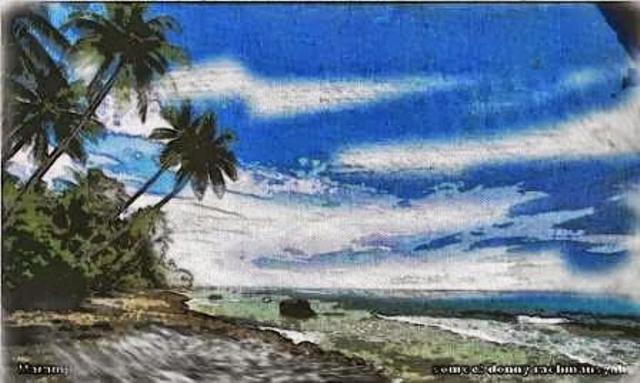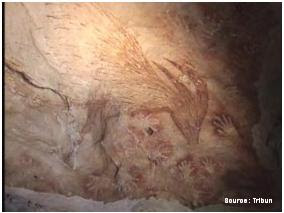Indonesia is not only rich in traditional and contemporary cultures but also in olden cultures reflected by many temples erected from around 500 AD. There are even numerous prehistoric remains such as megalithic and cave paintings discovered spread out throughout the archipelago.
The worldwide prehistoric era is still tightly covered by mystery. The civilizations seem to emerge out of sudden rising those of Sumerian, Babylonian and ancient Egypt around 10,000 BC. Before that time barely any information handed down to us except some artifacts in the form of cave paintings from prehistoric cave-dwelling people.
These artifacts survive for a very long time from the period as old as 35,000 years ago such as prehistoric paintings in Lascaux and Chauvet caves, France and 25,000 years ago in Western Cape, South Africa, and Santa Barbara, California, all measured by means of the radiocarbon date.
Indonesia seems also to be inhabited by numerous prehistoric people among other in Maros (Sulawesi) with the age estimated between 30,000 to 10,000 years, in Tewet (Kutai Regency, Kalimantan), more than 10,000 years, in Seram, Kei Islands, and Papua.
Indonesia seems also to be inhabited by numerous prehistoric people among other in Maros (Sulawesi) with the age estimated between 30,000 to 10,000 years, in Tewet (Kutai Regency, Kalimantan), more than 10,000 years, in Seram, Kei Islands, and Papua.
In Kalimantan, around 1,000 caves have been inventoried spread out throughout East Kalimantan province of which several caves are for burial rich of ceramics and 20 caves ornamented with prehistoric paintings. The paintings in those caves were made of the same non-organic materials, namely hematite, manganese dioxide and dust of karsts as a binder.
The models, techniques, and materials used for paintings are the same as the ones found in Australia. Some experts hold a chronological human ancestor distribution theory stipulating that early Aboriginal-resembled tribe lived from as far as Kalimantan in the west spread out throughout southern Moluccas archipelago down to Papua and Australia in the east.
The most dominant prehistoric cave paintings in Kalimantan, Sulawesi, Seram, Kei Islands, and West Papua are palm hands, both left and right. One of the paintings, “tree of life”, has attracted the attention of the expert worldwide. Aside from palm hands, others are paintings of animals, birds, and fish. As it was difficult for prehistoric people to gather materials to draw paintings, we can conclude that those paintings should have been drawn on special purpose.
The prehistoric tribes living in Maros cave painted the picture of anoas (dwarf buffaloes), horny-pigs or megapode birds with the hope that they could easily catch those animals during their hunting season. Inside the cave, the experts also found stone tools including ax, arrows and human bones.
That the prehistoric people could do any artistic works, it indicated that they had started to settle in a certain place, contrary to nomadic people, which had to wander here and there and had no time to express their feelings or to commemorate something with paintings.
Maros paintings have survived thousands of years but only a few years after discovered by locals, the paintings began to suffer from destruction.
As more and more people come to the site, it is the obligation of the local government to take the necessary steps to protect the cave and its contents properly.
As more and more people come to the site, it is the obligation of the local government to take the necessary steps to protect the cave and its contents properly.
Like Maros, Tewet cave paintings in Kutai, Kalimantan, need serious attention of the local government to conserve them. The destruction of the nearby forest might also change the humidity of the weather and in turn, might disturb the condition of the paintings.
It is interesting to note that some western authors claim that Indonesia was the East of Eden, a “paradise” that has been lost submerged below the sea level during a series of big floods to become a large archipelago as we know it today. The cave paintings discovered in numerous areas throughout the archipelago may support such postulate.
It is interesting to note that some western authors claim that Indonesia was the East of Eden, a “paradise” that has been lost submerged below the sea level during a series of big floods to become a large archipelago as we know it today. The cave paintings discovered in numerous areas throughout the archipelago may support such postulate.




No comments:
Post a Comment